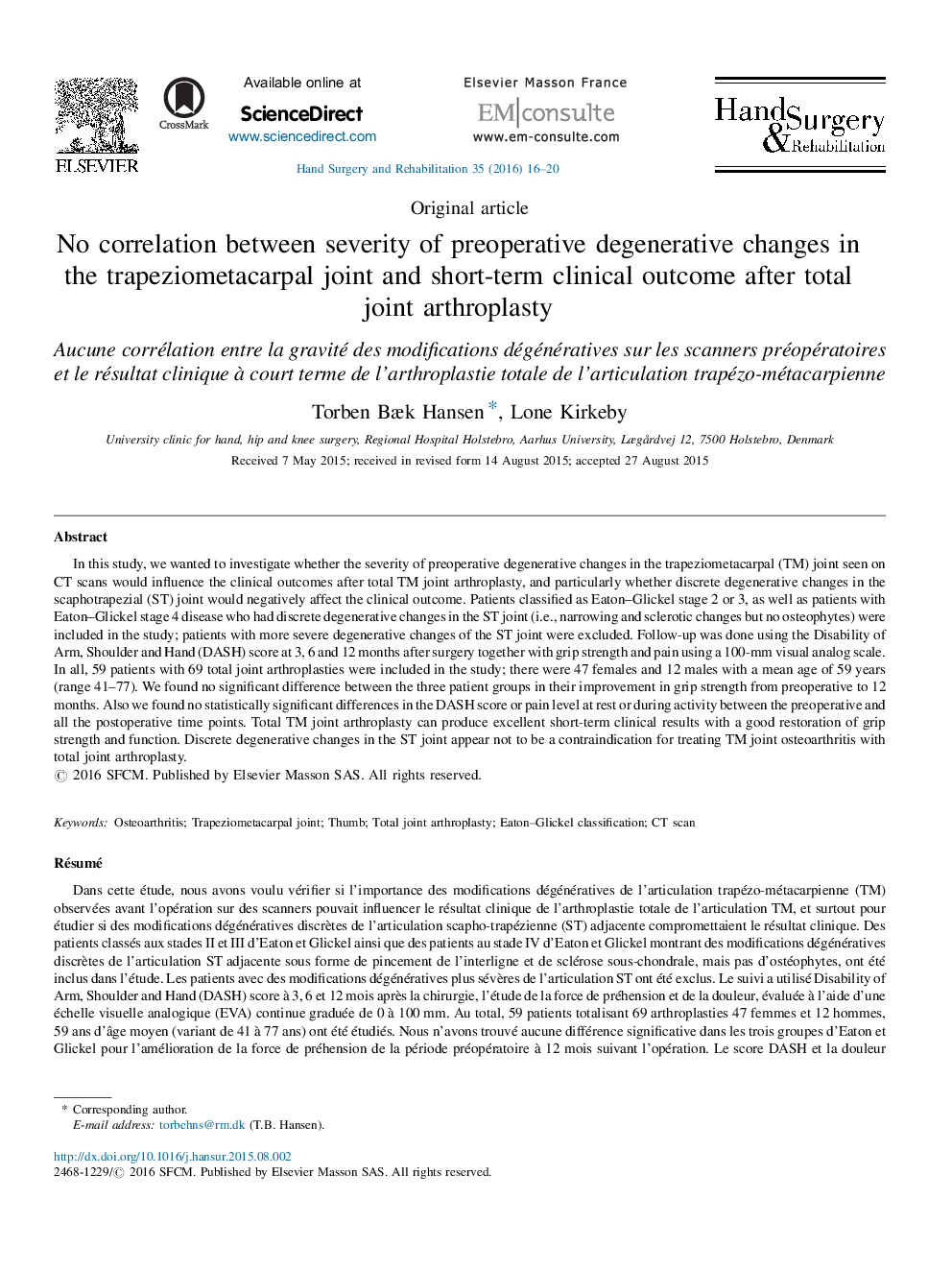| کد مقاله | کد نشریه | سال انتشار | مقاله انگلیسی | نسخه تمام متن |
|---|---|---|---|---|
| 4059768 | 1265868 | 2016 | 5 صفحه PDF | دانلود رایگان |
In this study, we wanted to investigate whether the severity of preoperative degenerative changes in the trapeziometacarpal (TM) joint seen on CT scans would influence the clinical outcomes after total TM joint arthroplasty, and particularly whether discrete degenerative changes in the scaphotrapezial (ST) joint would negatively affect the clinical outcome. Patients classified as Eaton–Glickel stage 2 or 3, as well as patients with Eaton–Glickel stage 4 disease who had discrete degenerative changes in the ST joint (i.e., narrowing and sclerotic changes but no osteophytes) were included in the study; patients with more severe degenerative changes of the ST joint were excluded. Follow-up was done using the Disability of Arm, Shoulder and Hand (DASH) score at 3, 6 and 12 months after surgery together with grip strength and pain using a 100-mm visual analog scale. In all, 59 patients with 69 total joint arthroplasties were included in the study; there were 47 females and 12 males with a mean age of 59 years (range 41–77). We found no significant difference between the three patient groups in their improvement in grip strength from preoperative to 12 months. Also we found no statistically significant differences in the DASH score or pain level at rest or during activity between the preoperative and all the postoperative time points. Total TM joint arthroplasty can produce excellent short-term clinical results with a good restoration of grip strength and function. Discrete degenerative changes in the ST joint appear not to be a contraindication for treating TM joint osteoarthritis with total joint arthroplasty.
RésuméDans cette étude, nous avons voulu vérifier si l’importance des modifications dégénératives de l’articulation trapézo-métacarpienne (TM) observées avant l’opération sur des scanners pouvait influencer le résultat clinique de l’arthroplastie totale de l’articulation TM, et surtout pour étudier si des modifications dégénératives discrètes de l’articulation scapho-trapézienne (ST) adjacente compromettaient le résultat clinique. Des patients classés aux stades II et III d’Eaton et Glickel ainsi que des patients au stade IV d’Eaton et Glickel montrant des modifications dégénératives discrètes de l’articulation ST adjacente sous forme de pincement de l’interligne et de sclérose sous-chondrale, mais pas d’ostéophytes, ont été inclus dans l’étude. Les patients avec des modifications dégénératives plus sévères de l’articulation ST ont été exclus. Le suivi a utilisé Disability of Arm, Shoulder and Hand (DASH) score à 3, 6 et 12 mois après la chirurgie, l’étude de la force de préhension et de la douleur, évaluée à l’aide d’une échelle visuelle analogique (EVA) continue graduée de 0 à 100 mm. Au total, 59 patients totalisant 69 arthroplasties 47 femmes et 12 hommes, 59 ans d’âge moyen (variant de 41 à 77 ans) ont été étudiés. Nous n’avons trouvé aucune différence significative dans les trois groupes d’Eaton et Glickel pour l’amélioration de la force de préhension de la période préopératoire à 12 mois suivant l’opération. Le score DASH et la douleur évaluée par l’EVA ne montraient aucune différence statistiquement significative au repos ou en activité de la période préopératoire à toute la période d’observation postopératoire. Cette étude ne montre aucune corrélation entre l’importance des modifications dégénératives sur les scanners préopératoires et le résultat clinique à court terme de l’arthroplastie totale TM.
Journal: Hand Surgery and Rehabilitation - Volume 35, Issue 1, February 2016, Pages 16–20
